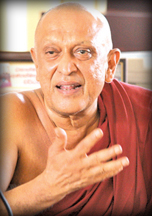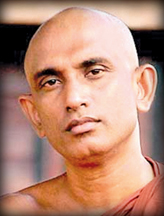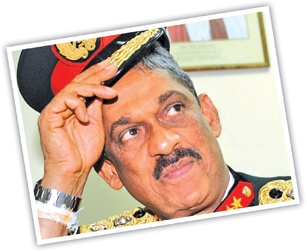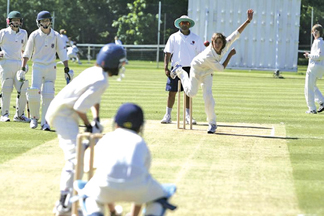 Your
View... Your
View...
Dear reader, the Sunday
Observer has revived the 'Letters to the Editor' column and
welcome your letters. Letters should be brief, legible and
contain the name, address and contact number of the writer.
Mail your letters to: 'Letters', The Sunday Observer, 35,
D.R.Wijewardene Mawatha, Colombo 10. Email:
[email protected]
Handwritten copies should be duly signed. |
Heroic bhikkus of today
|

Ven. Maduluwawe Sobhitha Thero |
|

Dr. Omalpe Sobhitha Thero |
|

Ven. Athuraliye Rathana Thero |
Our country is blessed with natural beauty, precocious culture and
history, great kings and their unbelievable creations for the benefit of
the country, relatively peaceful existence of four great religions of
the world (Buddhism being the largest among them), et al.
The history of Buddhism in Sri Lanka dates back to the 3rd century
BC, the era of King Devanampiya Tissa during whose time Ven. Arahath
Mahinda arrived and established Buddhism in our country. From that time,
Buddhist monasteries and Buddhist monuments were set up with the
patronage of the Sinhala Kings.
Among the monasteries, Isurumuni Vihara, Vessagiri Vihara, Mahavihara,
Abhayagiri Vihara, Jetavana Vihara were few of the most famous. Those
were the homes for many Buddhist monks in the past who dedicated their
entire lives for the uplift of Buddhism in this country. At present the
Temple of the Tooth Relic in Kandy built by King Narendrasinha is world
famous and the one of the most venerable places of the Buddhists all
over the world.
In our recent past history there were famous monks who fought against
colonialism and did yeoman services for the continuation and revival of
the Buddhism in Sri Lanka. Following are a few famous names that came to
mind.
Ven. Thotagamuwe Sri Rahula Thera (1408 - 1491) a multi-linguist who
was known as ‘Shad Bhasha Parameshwara’. Ven. Wariyapola Sri Sumangala,
(early 19th century) who was known for taking down the English flag and
re-hoisting the Sinhalese lion flag, before the convention that handed
over control of the country to the British in 1815. Ven. Migettuwatte
Gunananda Thera (1823 – 1890) who became famous for the debate in
Panadura. (Henry Steel Olcott came to Sri Lanka because of him) Ven.
Hikkaduwe Sri Sumangala thero (1827 – 1911) founder of Vidyodaya
Pirivena Maligakanda a University at present and a major figure in
Panadurawadaya. Ven. Sikkim Mahinda, commonly known as S. Mahinda, (died
in 1951) was a Buddhist monk from Tibet. He was a famous poet, author,
and participated in the Sri Lankan Independence movement.
Ven. Agga Maha Panditha Balangoda Ananda Maitreya Thero (1896 – 1998)
Sri Lankan Buddhists consider Balangoda Ananda Maitreya Thero as a
Bodhisattva. Ven. Walpola Rahula (1907–1997) was a famous intellectual
of the 20th century. Ven. Madihe Pannaseeha Thero (1913 - 2003) was the
head of Amarapura sect from 1969 until his death. Srimath Anagarika
Dharmapala (1864 – 1933) who became a Buddhist monk as Ven. Sri.
Devamitta Dharmapala, in 1933, the year he died in India.
Now it is the time to mention the names of the present day heroic
bhikkus who spoke and fought fearlessly against the last regime and
contributed immensely for a regime change. All Sri Lankans are well
aware of their patriotic conduct for the sake of our country. These
bhikkus could not be bought by people who spent lavishly for their
political campaigns.
Ven. Maduluwawe Sobhitha Thero, the chief incumbent of the Kotte Naga
Vihara. Ven. Athuraliye Rathana Thero, Ven. Dambara Amila Thero, Dr.
Omalpe Sobhitha Thero are the present day heroes who did not hesitate to
risk their lives for democracy in Sri Lanka. . The e country is grateful
to you and without any doubt your names will go down in history as Sri
Lankan heroes of the 21st century.
If the present leaders do not act swiftly to ameliorate the people’s
sufferings, make ours a corruption free country and deviate from the
promised ‘yahapalanaya’, the above Rev. Theros will be the firsts to
take to the streets, en masse to protest and clamour for justice.
A Roman Catholic,
Colombo
The grand old : Field Marshall
 Oh,
the grand old field marshall Oh,
the grand old field marshall
He had ten thousand men
He marched them up to the top of the hill,
And marched them down again.
When they were up, they were up,
When they were down, they were down,
When they were only half-way up,
They were neither up nor down.
Oh, he marched them to the left
He marched them to the right
He even marched them upside-down
Oh, what a grand sight!
He marched them to the left
He marched them to the right
He marched them ‘round and’ round again
And then straight out of sight.
Nihal Ratnayake,
Dehiwala.
'Importing' talented sportsmen
As the College's cricket season comes to a close and the rugger
season commences there is some concern by followers of the games that
some leading private schools have been in the act of 'importing' players
from lesser known schools to represent their College in both these
sports.
 The
modus operandi is to ensure that their school comes on top in these
major sports events, so some private schools go head hunting for
outstanding sportsman in the lesser known schools and fill in the slots
in the first XI or first XV of the leading Colleges hoping their
participation will bring credit to the school in terms of performance. The
modus operandi is to ensure that their school comes on top in these
major sports events, so some private schools go head hunting for
outstanding sportsman in the lesser known schools and fill in the slots
in the first XI or first XV of the leading Colleges hoping their
participation will bring credit to the school in terms of performance.
When such actions are taken by the school, it gives rise to
dissention among Old Boys of these schools that their off spring who
have been nurtured through their school career playing at junior and
intermediary levels, and hopeful of representing the College at the
highest level in the First Eleven or First Fifteen, are being deprived
of the opportunity of representing the College in these sports at this
level.
These concerns are understandable but also in the contrary, some Old
Boys have given their consent to the move with the motive probably to
'win at all cost' as a an act of loyalty.
At matches involving these Colleges it is common place to hear shouts
of 'Combined Schools' by the rival Colleges to spotlight this anomaly.
It would be advisable if the Education Department under whose purview
all schools come under, adopt a policy that to represent the School at
the highest level in sports that a requirement should be made that the
students involved should have been in that particular school for a
minimum of five years. Such a move will be in fairness to students who
aspire to represent their Colleges at the 1st XI or 1st XV in sports and
have been building up their sporting talent to meet this goal and they
feel deprived of this ambition by 'parachutist' students brought out
purely to see that College achieves top position in those sports fields.
M.Ghouse
Colombo
|

